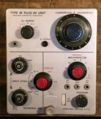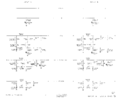W: Difference between revisions
David Wise (talk | contribs) mNo edit summary |
No edit summary |
||
| Line 8: | Line 8: | ||
series=[[500-series scopes]]| | series=[[500-series scopes]]| | ||
manuals= | manuals= | ||
* [http://bama.edebris.com/manuals/tek/w/ Tektronix Type W Manual (BAMA)] | * [http://w140.com/mmm/tek-w.pdf Tektronix Type W Manual (PDF)] | ||
* [http://bama.edebris.com/manuals/tek/w/ Tektronix Type W Manual (BAMA, offline?)] | |||
* [http://w140.com/tek_type_w_schematics.pdf Tektronix Type W Schematics Only (PDF)] | * [http://w140.com/tek_type_w_schematics.pdf Tektronix Type W Schematics Only (PDF)] | ||
}} | }} | ||
Revision as of 14:39, 4 September 2017
Template:Plugin Sidebar 2 The Tektronix Type W is a differential comparator plug-in amplifier for 500-series scopes. Its bandwidth varies from 23 MHz to 8 MHz depending on gain. Only modestly faster than its Type Z predecessor, Type W extends performance in terms of sensitivity, reaching 1 mV/div.
It achieves 20,000 to 1 common-mode rejection at DC and low frequencies. It has a built in precision variable voltage supply, "Vc", which is controlled by a ten-turn pot and can vary from either -1.1 V to +1.1 V or -11 V to +11 V.
Type W has two signal inputs, "A" and "B". A mode switch selects between displaying A-Vc, A-B, or Vc-B. The "A-B" mode is particularly useful for displaying the current in a sense resistor, while the other modes provide "slideback" measurements of small variations superimposed on a large constant.
An output of Vc is provided on the front panel of the Type W. Unlike the Z, Type W has two gain axes, a decade attenuator and a 1-2-5-10-20-50 selector, reminiscent of Type D from ten years before.
Type W is the only letter-series plug-in with an "infinite resistance" input mode selectable at the front panel. (Type 1A5 has an internal jumper that can be cut.)
In the letter-series timeline of differential comparators, Type W, introduced in 1965, follows Type Z and precedes Type 1A5.
Specifications
please add
Pictures
-
Front view.
-
Top-left view.
-
Bottom view.
-
Block Diagram
-
Differential Comparator
-
Input Attenuators
-
Switching Diagram






